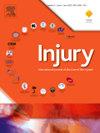Risk factors for cut-throughs in intertrochanteric hip fracture fixation Tip-Apex Distance (TAD) <10 mm and Apex-to-Center <4 mm
IF 2.2
3区 医学
Q3 CRITICAL CARE MEDICINE
Injury-International Journal of the Care of the Injured
Pub Date : 2025-02-07
DOI:10.1016/j.injury.2025.112205
引用次数: 0
Abstract
Objectives
TAD > 25 mm is a risk factor for cut-out in intramedullary nailing. Less attention has been given to the risk factors for central cut-through and the possible outcomes of TAD <10 mm. Furthermore, the risk of cut-through depending on minimum depth on either anterior-posterior (AP) or lateral views has not been explored. The goal of this study is to outline the parameters that increase risk of cut-through in intertrochanteric hip fractures.
Methods
A retrospective review of 2128 intertrochanteric hip fractures admitted to a single level 1 academic trauma center from 2014 – 2023 was conducted. Variables included patient and operative characteristics, fracture fixation device, fracture type based on OTA/AO 2018 classification, TAD, neck-shaft angle and radiographic and clinical outcomes.
Results
TAD <10 millimeters carried a significantly higher risk for lag screw and blade cut-through. Cut-through risk increased significantly when either AP or lateral apex-to-center distance was <4 millimeters, including when comparing fracture reduction quality for a cohort including sliding hip screws, lag screws and blades. Cut-out complications in this cohort only occurred with a TAD >10 mm and was significantly more likely to occur with TAD >25 mm, similar to prior studies.
Conclusion
TAD optimization between 10 and 25 mm reduces risk of both cut-out and cut-through and maintenance of 4 mm of distance between apex-to-center distance may help decrease the risk of cut-through complications.
求助全文
约1分钟内获得全文
求助全文
来源期刊
CiteScore
4.00
自引率
8.00%
发文量
699
审稿时长
96 days
期刊介绍:
Injury was founded in 1969 and is an international journal dealing with all aspects of trauma care and accident surgery. Our primary aim is to facilitate the exchange of ideas, techniques and information among all members of the trauma team.

 求助内容:
求助内容: 应助结果提醒方式:
应助结果提醒方式:


